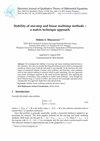Ground state solution for fractional problem with critical combined nonlinearities
IF 0.8
4区 数学
Q1 MATHEMATICS
Er-Wei Xu, Hong-Rui Sun
求助PDF
{"title":"Ground state solution for fractional problem with critical combined nonlinearities","authors":"Er-Wei Xu, Hong-Rui Sun","doi":"10.14232/ejqtde.2023.1.38","DOIUrl":null,"url":null,"abstract":"<jats:p>This paper is concerned with the following nonlocal problem with combined critical nonlinearities <mml:math xmlns:mml=\"http://www.w3.org/1998/Math/MathML\" xmlns=\"http://www.w3.org/1998/Math/MathML\" display=\"block\"> <mml:mo stretchy=\"false\">(</mml:mo> <mml:mo>−<!-- − --></mml:mo> <mml:mi mathvariant=\"normal\">Δ<!-- Δ --></mml:mi> <mml:msup> <mml:mo stretchy=\"false\">)</mml:mo> <mml:mrow class=\"MJX-TeXAtom-ORD\"> <mml:mi>s</mml:mi> </mml:mrow> </mml:msup> <mml:mi>u</mml:mi> <mml:mo>=</mml:mo> <mml:mo>−<!-- − --></mml:mo> <mml:mi>α<!-- α --></mml:mi> <mml:mrow class=\"MJX-TeXAtom-ORD\"> <mml:mo stretchy=\"false\">|</mml:mo> </mml:mrow> <mml:mi>u</mml:mi> <mml:msup> <mml:mrow class=\"MJX-TeXAtom-ORD\"> <mml:mo stretchy=\"false\">|</mml:mo> </mml:mrow> <mml:mrow class=\"MJX-TeXAtom-ORD\"> <mml:mi>q</mml:mi> <mml:mo>−<!-- − --></mml:mo> <mml:mn>2</mml:mn> </mml:mrow> </mml:msup> <mml:mi>u</mml:mi> <mml:mo>+</mml:mo> <mml:mi>β<!-- β --></mml:mi> <mml:mrow class=\"MJX-TeXAtom-ORD\"> <mml:mi>u</mml:mi> </mml:mrow> <mml:mo>+</mml:mo> <mml:mi>γ<!-- γ --></mml:mi> <mml:mrow class=\"MJX-TeXAtom-ORD\"> <mml:mo stretchy=\"false\">|</mml:mo> </mml:mrow> <mml:mi>u</mml:mi> <mml:msup> <mml:mrow class=\"MJX-TeXAtom-ORD\"> <mml:mo stretchy=\"false\">|</mml:mo> </mml:mrow> <mml:mrow class=\"MJX-TeXAtom-ORD\"> <mml:msubsup> <mml:mn>2</mml:mn> <mml:mrow class=\"MJX-TeXAtom-ORD\"> <mml:mi>s</mml:mi> </mml:mrow> <mml:mrow class=\"MJX-TeXAtom-ORD\"> <mml:mo>∗<!-- ∗ --></mml:mo> </mml:mrow> </mml:msubsup> <mml:mo>−<!-- − --></mml:mo> <mml:mn>2</mml:mn> </mml:mrow> </mml:msup> <mml:mi>u</mml:mi> <mml:mspace width=\"1em\" /> <mml:mtext>in</mml:mtext> <mml:mtext> </mml:mtext> <mml:mi mathvariant=\"normal\">Ω<!-- Ω --></mml:mi> <mml:mo>,</mml:mo> <mml:mspace width=\"1em\" /> <mml:mspace width=\"1em\" /> <mml:mi>u</mml:mi> <mml:mo>=</mml:mo> <mml:mn>0</mml:mn> <mml:mspace width=\"1em\" /> <mml:mtext>in</mml:mtext> <mml:mtext> </mml:mtext> <mml:msup> <mml:mrow class=\"MJX-TeXAtom-ORD\"> <mml:mi mathvariant=\"double-struck\">R</mml:mi> </mml:mrow> <mml:mrow class=\"MJX-TeXAtom-ORD\"> <mml:mi>N</mml:mi> </mml:mrow> </mml:msup> <mml:mi class=\"MJX-variant\" mathvariant=\"normal\">∖<!-- ∖ --></mml:mi> <mml:mi mathvariant=\"normal\">Ω<!-- Ω --></mml:mi> <mml:mo>,</mml:mo> </mml:math> where <mml:math xmlns:mml=\"http://www.w3.org/1998/Math/MathML\" xmlns=\"http://www.w3.org/1998/Math/MathML\"> <mml:mi>s</mml:mi> <mml:mo>∈<!-- ∈ --></mml:mo> <mml:mo stretchy=\"false\">(</mml:mo> <mml:mn>0</mml:mn> <mml:mo>,</mml:mo> <mml:mn>1</mml:mn> <mml:mo stretchy=\"false\">)</mml:mo> </mml:math>, <mml:math xmlns:mml=\"http://www.w3.org/1998/Math/MathML\" xmlns=\"http://www.w3.org/1998/Math/MathML\"> <mml:mi>N</mml:mi> <mml:mo>></mml:mo> <mml:mn>2</mml:mn> <mml:mi>s</mml:mi> </mml:math>, <mml:math xmlns:mml=\"http://www.w3.org/1998/Math/MathML\" xmlns=\"http://www.w3.org/1998/Math/MathML\"> <mml:mi mathvariant=\"normal\">Ω<!-- Ω --></mml:mi> <mml:mo>⊂<!-- ⊂ --></mml:mo> <mml:msup> <mml:mrow class=\"MJX-TeXAtom-ORD\"> <mml:mi mathvariant=\"double-struck\">R</mml:mi> </mml:mrow> <mml:mi>N</mml:mi> </mml:msup> </mml:math> is a bounded <mml:math xmlns:mml=\"http://www.w3.org/1998/Math/MathML\" xmlns=\"http://www.w3.org/1998/Math/MathML\"> <mml:msup> <mml:mi>C</mml:mi> <mml:mrow class=\"MJX-TeXAtom-ORD\"> <mml:mn>1</mml:mn> <mml:mo>,</mml:mo> <mml:mn>1</mml:mn> </mml:mrow> </mml:msup> </mml:math> domain with Lipschitz boundary, <mml:math xmlns:mml=\"http://www.w3.org/1998/Math/MathML\" xmlns=\"http://www.w3.org/1998/Math/MathML\"> <mml:mi>α<!-- α --></mml:mi> </mml:math> is a positive parameter, <mml:math xmlns:mml=\"http://www.w3.org/1998/Math/MathML\" xmlns=\"http://www.w3.org/1998/Math/MathML\"> <mml:mi>q</mml:mi> <mml:mo>∈<!-- ∈ --></mml:mo> <mml:mo stretchy=\"false\">(</mml:mo> <mml:mn>1</mml:mn> <mml:mo>,</mml:mo> <mml:mn>2</mml:mn> <mml:mo stretchy=\"false\">)</mml:mo> </mml:math>, <mml:math xmlns:mml=\"http://www.w3.org/1998/Math/MathML\" xmlns=\"http://www.w3.org/1998/Math/MathML\"> <mml:mi>β<!-- β --></mml:mi> </mml:math> and <mml:math xmlns:mml=\"http://www.w3.org/1998/Math/MathML\" xmlns=\"http://www.w3.org/1998/Math/MathML\"> <mml:mi>γ<!-- γ --></mml:mi> </mml:math> are positive constants, and <mml:math xmlns:mml=\"http://www.w3.org/1998/Math/MathML\" xmlns=\"http://www.w3.org/1998/Math/MathML\"> <mml:msubsup> <mml:mn>2</mml:mn> <mml:mrow class=\"MJX-TeXAtom-ORD\"> <mml:mi>s</mml:mi> </mml:mrow> <mml:mrow class=\"MJX-TeXAtom-ORD\"> <mml:mo>∗<!-- ∗ --></mml:mo> </mml:mrow> </mml:msubsup> <mml:mo>=</mml:mo> <mml:mn>2</mml:mn> <mml:mi>N</mml:mi> <mml:mrow class=\"MJX-TeXAtom-ORD\"> <mml:mo>/</mml:mo> </mml:mrow> <mml:mo stretchy=\"false\">(</mml:mo> <mml:mi>N</mml:mi> <mml:mo>−<!-- − --></mml:mo> <mml:mn>2</mml:mn> <mml:mi>s</mml:mi> <mml:mo stretchy=\"false\">)</mml:mo> </mml:math> is the fractional critical exponent. For <mml:math xmlns:mml=\"http://www.w3.org/1998/Math/MathML\" xmlns=\"http://www.w3.org/1998/Math/MathML\"> <mml:mi>γ<!-- γ --></mml:mi> <mml:mo>></mml:mo> <mml:mn>0</mml:mn> </mml:math>, if <mml:math xmlns:mml=\"http://www.w3.org/1998/Math/MathML\" xmlns=\"http://www.w3.org/1998/Math/MathML\"> <mml:mi>N</mml:mi> <mml:mo>⩾<!-- ⩾ --></mml:mo> <mml:mn>4</mml:mn> <mml:mi>s</mml:mi> </mml:math> and <mml:math xmlns:mml=\"http://www.w3.org/1998/Math/MathML\" xmlns=\"http://www.w3.org/1998/Math/MathML\"> <mml:mn>0</mml:mn> <mml:mo><</mml:mo> <mml:mi>β<!-- β --></mml:mi> <mml:mo><</mml:mo> <mml:msub> <mml:mi>λ<!-- λ --></mml:mi> <mml:mrow class=\"MJX-TeXAtom-ORD\"> <mml:mn>1</mml:mn> <mml:mo>,</mml:mo> <mml:mi>s</mml:mi> </mml:mrow> </mml:msub> </mml:math>, or <mml:math xmlns:mml=\"http://www.w3.org/1998/Math/MathML\" xmlns=\"http://www.w3.org/1998/Math/MathML\"> <mml:mi>N</mml:mi> <mml:mo>></mml:mo> <mml:mn>2</mml:mn> <mml:mi>s</mml:mi> </mml:math> and <mml:math xmlns:mml=\"http://www.w3.org/1998/Math/MathML\" xmlns=\"http://www.w3.org/1998/Math/MathML\"> <mml:mi>β<!-- β --></mml:mi> <mml:mo>⩾<!-- ⩾ --></mml:mo> <mml:msub> <mml:mi>λ<!-- λ --></mml:mi> <mml:mrow class=\"MJX-TeXAtom-ORD\"> <mml:mn>1</mml:mn> <mml:mo>,</mml:mo> <mml:mi>s</mml:mi> </mml:mrow> </mml:msub> </mml:math> , we show that the problem possesses a ground state solution when <mml:math xmlns:mml=\"http://www.w3.org/1998/Math/MathML\" xmlns=\"http://www.w3.org/1998/Math/MathML\"> <mml:mi>α<!-- α --></mml:mi> </mml:math> is sufficiently small.</jats:p>","PeriodicalId":50537,"journal":{"name":"Electronic Journal of Qualitative Theory of Differential Equations","volume":"1 1","pages":""},"PeriodicalIF":0.8000,"publicationDate":"2023-01-01","publicationTypes":"Journal Article","fieldsOfStudy":null,"isOpenAccess":false,"openAccessPdf":"","citationCount":"0","resultStr":null,"platform":"Semanticscholar","paperid":null,"PeriodicalName":"Electronic Journal of Qualitative Theory of Differential Equations","FirstCategoryId":"100","ListUrlMain":"https://doi.org/10.14232/ejqtde.2023.1.38","RegionNum":4,"RegionCategory":"数学","ArticlePicture":[],"TitleCN":null,"AbstractTextCN":null,"PMCID":null,"EPubDate":"","PubModel":"","JCR":"Q1","JCRName":"MATHEMATICS","Score":null,"Total":0}
引用次数: 0
引用
批量引用
Abstract
This paper is concerned with the following nonlocal problem with combined critical nonlinearities ( − Δ ) s u = − α | u | q − 2 u + β u + γ | u | 2 s ∗ − 2 u in Ω , u = 0 in R N ∖ Ω , where s ∈ ( 0 , 1 ) , N > 2 s , Ω ⊂ R N is a bounded C 1 , 1 domain with Lipschitz boundary, α is a positive parameter, q ∈ ( 1 , 2 ) , β and γ are positive constants, and 2 s ∗ = 2 N / ( N − 2 s ) is the fractional critical exponent. For γ > 0 , if N ⩾ 4 s and 0 < β < λ 1 , s , or N > 2 s and β ⩾ λ 1 , s , we show that the problem possesses a ground state solution when α is sufficiently small.
临界组合非线性分数阶问题的基态解
这篇文章是关心世事with the跟踪nonlocal组合连接在一起的问题nonlinearities(−Δ ) s u =−α | u | q−2 u +βu +γ | u | 2 s ∗ 在−2 u在Ω,u = 0 R N∖Ω,哪里s∈(0,1),N > 2 s,Ω⊂ R N a bounded C是 1 , Lipschitz 1和域边界,α是一个积极,q参数∈(1、2)、β和γ是阳性constants 2 s ∗ = 2 N / ( N s−2)是《fractional连接exponent。为γs > 0,如果N⩾4和0βλ 1 , s,或者N > 2和β⩾λ 1 , s,我们的节目就是《地面possesses a state university)溶液问题当α是足够小。
本文章由计算机程序翻译,如有差异,请以英文原文为准。
来源期刊
期刊介绍:
The Electronic Journal of Qualitative Theory of Differential Equations (EJQTDE) is a completely open access journal dedicated to bringing you high quality papers on the qualitative theory of differential equations. Papers appearing in EJQTDE are available in PDF format that can be previewed, or downloaded to your computer. The EJQTDE is covered by the Mathematical Reviews, Zentralblatt and Scopus. It is also selected for coverage in Thomson Reuters products and custom information services, which means that its content is indexed in Science Citation Index, Current Contents and Journal Citation Reports. Our journal has an impact factor of 1.827, and the International Standard Serial Number HU ISSN 1417-3875.
All topics related to the qualitative theory (stability, periodicity, boundedness, etc.) of differential equations (ODE''s, PDE''s, integral equations, functional differential equations, etc.) and their applications will be considered for publication. Research articles are refereed under the same standards as those used by any journal covered by the Mathematical Reviews or the Zentralblatt (blind peer review). Long papers and proceedings of conferences are accepted as monographs at the discretion of the editors.

 求助内容:
求助内容: 应助结果提醒方式:
应助结果提醒方式:


